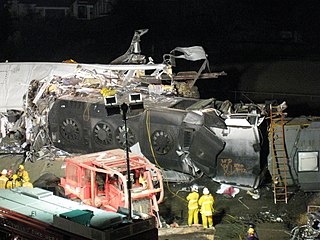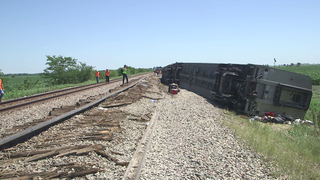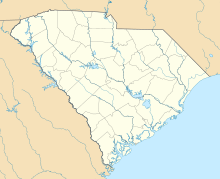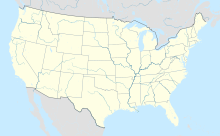
CSX Transportation, known colloquially as simply CSX, is a Class I freight railroad company operating in the Eastern United States and the Canadian provinces of Ontario and Quebec. The railroad operates on approximately 21,000 route miles (34,000 km) of track. The company operates as the leading subsidiary of CSX Corporation, a Fortune 500 company headquartered in Jacksonville, Florida.

On September 22, 1993, an Amtrak train derailed on the CSX Transportation Big Bayou Canot Bridge near Mobile, Alabama, United States. It was caused by displacement of a span and deformation of the rails when a tow of heavy barges collided with the rail bridge eight minutes earlier. Forty-seven people were killed and 103 more were injured. To date, it is the deadliest train wreck in both Amtrak's history and Alabama's railway history. It is also the worst rail disaster in the United States since the 1958 Newark Bay rail accident, in which 48 people died.

On March 15, 1999, Amtrak's southbound City of New Orleans passenger train collided with a semi-trailer truck in the village of Bourbonnais, Illinois, United States. Most of the train derailed, killing eleven people. A National Transportation Safety Board (NTSB) investigation into the accident attributed the cause to the truck driver trying to beat the train across a grade crossing. The NTSB's recommendations from the accident included increased enforcement of grade crossing signals, the installation of train event recorders at all new or improved grade crossings, and procedures to provide emergency responders with accurate lists of all crew members and passengers aboard trains. The city of Bourbonnais erected a memorial near the site to commemorate those killed in the accident.
On 8 February 1986, twenty-three people were killed in a collision between a Canadian National Railway freight train and a Via Rail passenger train called the Super Continental, including the engine crews of both trains. It was the deadliest rail disaster in Canada since the Dugald accident of 1947, which had thirty-one fatalities, and was not surpassed until the Lac-Mégantic rail disaster in 2013, which resulted in 47 deaths.

On January 4, 1987, two trains collided on Amtrak's Northeast Corridor main line near Chase, Maryland, United States, at Gunpow Interlocking. Amtrak train 94, the Colonial, traveling north from Washington, D.C., to Boston, crashed at over 100 miles per hour (160 km/h) into a set of Conrail locomotives running light which had fouled (entered) the mainline. Fourteen passengers on the Amtrak train died, as well as the Amtrak engineer and lounge car attendant.

The 2008 Chatsworth train collision occurred at 4:22:23 p.m. PDT on September 12, 2008, when a Union Pacific freight train and a Metrolink commuter train collided head-on in the Chatsworth neighborhood of Los Angeles, California, United States.

On February 16, 1996, a MARC commuter train collided with Amtrak's Capitol Limited passenger train in Silver Spring, Maryland, United States, killing three crew and eight passengers on the MARC train; a further eleven passengers on the same train and fifteen passengers and crew on the Capitol Limited were injured. Total damage was estimated at $7.5 million.

The 2015 Oxnard train derailment occurred on February 24, 2015, at 5:44 a.m. local time when a Metrolink passenger train collided with a truck that a driver had mistakenly turned from Rice Avenue onto the tracks and became stuck. After impact, the train derailed at Oxnard, California, United States. As a result of the crash, the train engineer died from his injuries a week later and 32 passengers and crew members were injured. The truck driver exited his vehicle and ran from the scene prior to the crash; he sustained minor injuries that were unrelated to the crash sequence.

On March 9, 2015, an Amtrak passenger train derailed in Halifax, North Carolina, after colliding with a truck carrying an oversize load that was obstructing the line at a grade crossing. There were no fatalities, but 55 people were injured.

On December 18, 2017, Amtrak Cascades passenger train 501 derailed near DuPont, Washington, United States. The National Transportation Safety Board's (NTSB) final report said regional transit authority Sound Transit failed to take steps to mitigate a curve at the accident location, and inadequately trained the train engineer. The train was making the inaugural run of the Point Defiance Bypass, a new passenger rail route south of Tacoma, Washington, operated by Amtrak in partnership with state and local authorities in Oregon and Washington, on right-of-way owned and operated by Sound Transit. The bypass was intended to reduce congestion and separate passenger and freight traffic, and was designed for faster speeds and shorter travel times, saving ten minutes from Seattle to Portland compared with the previous route used by Cascades.

The Crozet, Virginia train crash was a railway accident that occurred on January 31, 2018. A chartered Amtrak train named Congressional Special Train 923, following the route normally used by the Amtrak Cardinal and carrying a group of politicians and lawmakers from the Republican Party, collided with a garbage truck at a level crossing at Lanetown Road in Crozet, Virginia, 12 miles (19 km) west of Charlottesville, Virginia. The train was chartered by Republican lawmakers for transportation from Washington Union Station to an annual retreat at The Greenbrier in White Sulphur Springs, West Virginia. Several politicians brought their spouses and children with them for the trip; no members of the general public were passengers.

On June 27, 2022, the Southwest Chief, a passenger train operated by Amtrak, derailed near the small town of Mendon, Missouri. The derailment was caused by the train striking a dump truck that was obstructing the crossing of County Road 113, about three miles (4.8 km) southwest of Mendon. Four people were killed in the wreck: three passengers on board the train and the truck driver, with up to 150 people injured.













